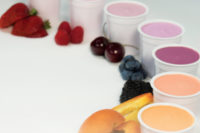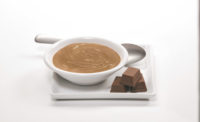You’ve got to hand it to Greek yogurt. No other product has done more to bring positive attention — and sales growth — to the dairy category. Retail sales of the high-protein dairy food grew more than 50% in 2012, hitting $1.6 billion, according to Packaged Facts. Sales continued to rise well into the first quarter of 2013.
It’s easy to see why. In an era when reading ingredient statements can trigger mild anxiety attacks in even the most sanguine of consumers, Greek yogurt has a refreshing tendency to contain the “right stuff:” honey, super fruits, probiotics and natural flavors. These ingredients and words resonate with consumers.
But one thing they’re not likely to see on a Greek yogurt label is an FD&C number — the telltale mark of a synthetic colorant. And while such colors are certified by the Food and Drug Administration, they just don’t jibe with the “all-natural” appeal of the Greek yogurt concept. Or with an expanding number of dairy concepts, it turns out. As consumers’ loyalties shift toward ingredients they can feel good about, natural colorants are becoming dairy’s new normal.
It all started with annatto
Though natural colors (more accurately, colorants exempt from FDA certification) are dairy’s new normal, they’re hardly new, per se.
As Tim Truby, vice president, food and color technology, Wild Flavors Inc., Erlanger, Ky., notes, “Natural colors have been around for hundreds of years. Colors such as carmine and cochineal were once the main coloring pigments in the clothing of royalty.”
Fair enough, but whether they served the same purpose in the royal ice cream, we may never know. As for the advent of natural colors for food use, Truby dates the creation of annatto by Christian Hansen for application in cheese to the early 1900s. And it’s hard to remember a time when beta carotene didn’t give pale winter butter a more summery yellowish hue.
Nevertheless, the recent insistence upon naturally derived colorants is a contemporary trend, and when Truby looks into his crystal ball, “It’s of my opinion that natural colors will overtake synthetics in five to 10 years,” he said.
He has the data on his side, as Leatherhead Food Research notes in its “Food Colours Report 2013.” Global sales of natural colors outpaced those of their artificial counterparts for the first time in 2011 — a trajectory that’s likely to rise.
Don’t mourn the passing of synthetics just yet, though. While he said he is expecting “steady growth” for exempt colors in the dairy industry, Rajesh Cherian, the manager of application support for natural colors at ROHA Group USA in St. Louis, maintains that “the demand for artificial colors has not decreased. It has remained very consistent and we expect to see that trend continue.”
Cherian credits their easy application, stability, “vast array of achievable color shades” and general economy in use for synthetics’ staying power.
Jody Renner-Nantz, dairy application scientist at D.D. Williamson (DDW), Louisville, Ky., added that while natural use will grow, “synthetics will still dominate the U.S. market unless regulatory directives eliminate synthetic colors, or cost gaps shrink between synthetics and ‘naturals.’”
Regulatory directives have set the tone in Europe, where “natural colors now totally replace synthetic colors in dairy applications,” said Mathilde Brousse, an R&D engineer in colorants for David Michael Europe, based in Valence, France. She traces the shift to the Southampton study, which linked synthetic colors to hyperactivity in children and compelled the European Food Safety Authority to mandate that products containing synthetic colorants warn consumers that they “may have an adverse effect on activity and attention in children,” Brousse said.
While the mandate doesn’t ban the colors outright, the cautionary labeling might as well.
Listen to the consumer
The fact that a mere warning can effectively take synthetics off European shelves underscores the might that consumers have in this matter. As Truby noted, “Consumer demand drives regulatory reaction, and the shift begins. We’re seeing this play out now in the natural color world.”
At DSM Nutritional Products in Parsippany, N.J., Marketing Manager for Digestive Enzymes Nithya Hariharan would agree. After all, as powerful as regulations may be, she said, they “have their strong impact because they place a responsibility on the industry to provide accurate information to consumers.”
And consumers armed with the Internet and social media are on the hunt for just that: information, albeit “positive and negative; accurate and erroneous,” said Hariharan.
Marlena Hidlay, marketing analyst for food and beverage at DSM, points to findings from the 2013 “Study of Consumer Awareness & Perceptions of Food Coloring Ingredients” that “67% of consumers check product labels to see which ingredients color their foods and beverages,” she said.
Retailers shape the scene, too. “When Whole Foods published its lists of unacceptable ingredients, it influenced food manufacturers to formulate finished products using more natural ingredients,” said Business Manager Nathalie Pauleau of Naturex, Avignon, France.
Next-generation naturals
Today’s natural colors are better than earlier generations. Once notoriously sensitive to heat, light, oxygen, pH and interactions with other ingredients, natural colors are more stable, more soluble and easier to work with than ever.
This has been a boon to dairy processors, whose products pose formulation and stability challenges, ranging from vitamin and mineral fortification to high-temperature processing and pH levels above where natural colors are traditionally comfortable. But those in the know insist that coloring dairy with the latest-generation of natural colors need not be any more trying than if synthetics were in the mix.
You can thank improvements in emulsion technologies, Pauleau said, which buttress exempt colors’ stability toward acid and oxidation. A wider selection of solubilities and delivery formats (powder or liquid) also helps, she noted.
Renner-Nantz said that new emulsification technologies liberate hues traditionally associated with water-soluble colors for use in oil-based systems. “These naturally derived colors, particularly pink and purple hues from water-soluble fruit and vegetable pigments, add a vibrancy to compound coatings or other oil-based foods,” she said.
Diane Hnat, senior technical marketing manager for food and beverage at DSM, notes that in addition to improved emulsions, there are beadlets, spray-dried forms and new GRAS-status ingredients to add to manufacturers’ options.
Color their world
“The use of natural colors continues to increase, which demonstrates to me that people are becoming more familiar with using them,” Truby said.
When making the switch from synthetics to naturals, it still helps to have an able guide.
“There are certain considerations to be made,” Trudy said. He advises manufacturers to work with their colorant suppliers “early in the development process. We’re constantly evaluating new stabilization methods and learning how to avoid gaps and pitfalls when natural colors are used with unique or new raw materials.”
CEO Stefan Hake of GNT USA also counsels collaboration. “Using yogurt as an example, the desired color hue typically matches a fruit flavor profile,” he said. “In this circumstance, understanding the processing of the fruit preparation is key. Therefore, working together with the right fruit preparation supplier to execute the optimal color system allows us to achieve success.”
Indeed, yogurt illustrates how natural colorant solubility comes into play in the dairy medium. As Renner-Nantz explained, “Water-soluble coloring in fruit preparations tends to ‘bleed’ into yogurt.”
An oil-dispersible technology coupled with a blend of natural red colors can solve the problem. The approach can help yogurt manufacturers maintain a swirled fruit appearance for consumers,” she said.
Solubility can be a tricky matter with natural colors across dairy applications. Renner-Nantz notes that lake forms of natural colorants, such as carmine, can have “mixed results in dairy” as the metallic portion of the lake binds dairy’s calcium and precipitates.
Todd Katz, an applications lab manager at DSM Nutritional Products, said that “natural colors are not always soluble by chemistry standards and may be suspensions of insoluble crystals such as beta carotene.” That’s why color suppliers develop formats with the finished application in mind. Examples are oil-based fluid suspension for margarines or butter and water-dispersible powders for milk.
Such targeted forms have helped reduce the phenomenon of ringing, Katz said, “where some oil-soluble or insoluble crystals escape from the matrix and migrate to the air-water interface.”
Setting the right tone
Setting solubility aside, the question remains: How does the color actually look in the product? When that product is milk, yogurt or ice cream, the backdrop itself can have a noticeable effect.
“Natural colors fade to pastel, given the opaque white background of most dairy products,” Renner-Nantz said. “But this can be overcome somewhat by increasing dosage rate.”
And the stability of different natural options in the dairy environment can make finished color something of a moving target.
“The hardest color to achieve naturally in dairy is red,” Truby said.
To get the classic strawberry-milk pink that used to come from FD&C Reds No. 3 and 40 and FD&C Blue No. 1, for example, a dairy processor could use carmine. But its heat stability and tolerability to milk’s neutral pH come at the price of being non-vegetarian and not kosher. And while beet juice can handle high-pH systems, it is not very heat or light stable.
A combination of beet juice with caramel color can be a successful replacement for synthetic reds.
Color technology can combine multiple oil- and water-based natural colors in a complex color matrix that provides bright, natural red shades that are heat resistant, prevent color bleed and improve color consistency, said Mike Geraghty, president, color group, Sensient Technologies Corp., St. Louis.
But perhaps even harder to nail than the perfect natural red is any natural blue or green. “Blue shades develop when anthocyanins are exposed to neutral pH, like that of milk,” Renner-Nantz said. “However, the pigment fades to gray.”
This may be changing. At least two suppliers have launched natural blue colors said to be stable in low- and high-pH dairy environments.
For all the new-found attention on natural colors, it’s wise to keep some perspective. Consider this observation by Carol Locey, director, product management, colors, at Kalsec Inc., Kalamazoo, Mich.” “The dairy industry is unique in having a long history of using natural rather than synthetics colors,” she said. “Natural cheese, processed cheese and cheese powders have traditionally been colored with annatto, paprika and turmeric. There is no need to change now.”
Editor's note: This article was updated on Sept. 25. Comments that had been attributed to Karine Morel should have been attributed to Nathalie Pauleau.






